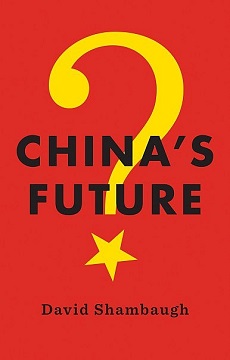The path which China will pursue in the coming future is one of the most debated and discussed topic among the current academic and policy making circle. The direction which Chinese politics, society and economy adopt almost directly impacts a large number of countries. In the book China’s Future, David Shambaugh discusses a number of scenarios which may pan out depending on the path which the Chinese political system under the Chinese Communist Party (CCP) adopts under Xi Jinping.
Shambaugh provides four different trajectories which China may move towards. He calls them, Neo-Totalitarian, Hard Authoritarian, Soft Authoritarian and Semi-Democracy. However, considering that the book was written in 2017 and the 19th Party Congress and the National People’s Congress of 2018 have changed the Chinese political structure, notably three of the options (Hard Authoritarian, Soft Authoritarian and Semi-Democracy) are clearly no more an alternative for the Chinese government. Though the author appeared hopeful that Xi Jinping will hold power only until 2022 the current reality is quite different. However, the abolition of the Presidential term limit changes the reality of Chinese politics from the situation in 2017. The current government under the leadership of Xi Jinping is highly controlling and China is definitely on the path of Neo-Totalitarian, which is one of the options discussed by Shambaugh. But Shambaugh in his arguments appears quite confident and convinced that China may not take this path but will continue on the trajectory of Hard Authoritarianism.
While discussing the path of Hard Authoritarianism, Shambaugh argues, “….Hard Authoritarianism is a recipe for economic stagnation, social instability, and the political decline of the Chinese Communist Party. Xi Jinping and his comrades may think this is the right path for China and for their remaining in power – but I believe it is a fundamental miscalculation”. He had further argued that China will continue on the path of Hard Authoritarianism till the 19th Party Congress. But he had also argued that China may move towards Soft Authoritarianism after that keeping in view the upcoming changes in the Party representatives. However, this hope proved to be wrong. The hope for Chinese politics to witness changes equal in nature as the Chinese economy has been alluring the world for a long time. The Chinese state under the CCP has proved that it is very comfortable and confident in keeping the politics and economy into water tight compartments. After the opening up there was a call for political reforms in China but they were militarily silenced. Since then there has been no new threat to the legitimacy of the CCP. However, the changes within the Chinese society have proved to be a difficult task for the CCP to adapt to.
So the Chinese course of Neo-Totalitarianism will not only affect its domestic politics, society and economy but will have an important influence on its relationship with its neighbours. As China becomes aggressive it increases the insecurity and distrust amongst its neighbours. This change is also followed by an increase in domestic nationalism. The Chinese nationalism is directly aimed at Japan, the United States and Taiwan. However, the CCP has been using it as and when it required the people’s opinion to be line with the government’s policies, whether domestic or international. Under Xi nationalism will be gaining greater support and may be directed at a large number of issues, both domestic and international. Under Xi China is also moving towards a highly controlled state with no hope for any kind of political transformation. The changes within the Chinese society are also being curtailed under Xi as China is witnessing a highly monitored society.
Throughout the book Shambaugh argues that the best course for China under CCP is to either take the course of Semi Democracy or Soft Authoritarianism. He asserts that these are the two options which will prove highly beneficial for both the Chinese economy as well as the Chinese foreign policy. The problem is that though he does discuss in detail the Hard Authoritarian, Soft Authoritarian and Semi Democracy, he does not invest equal amount of effort discussing the probability of Neo Totalitarian, thus under pinning the argument that the changes within Chinese politics and CCP are not in line as predicted or expected by the author. However, even though the change in Chinese politics questions the benefit of reading this book in the year 2018, one cannot ignore the insights which the author provides regarding the changes within the Chinese society and economy.
The political reality in China may have changed but the issues troubling and shaping the direction of the Chinese society (aging population, increasing income inequalities, pollution, etc.) and economy remain the same. The increased control under Xi may further aggravate the current problems which affect the Chinese society. Thus, the book is useful for students, scholars and practitioners.










Post new comment